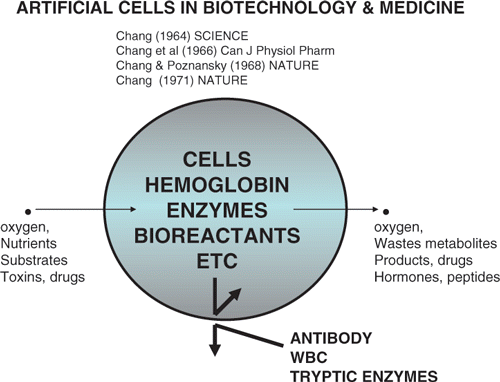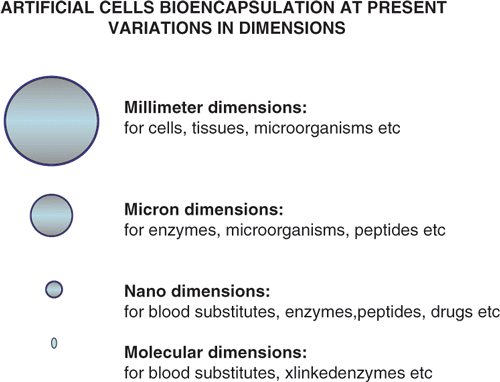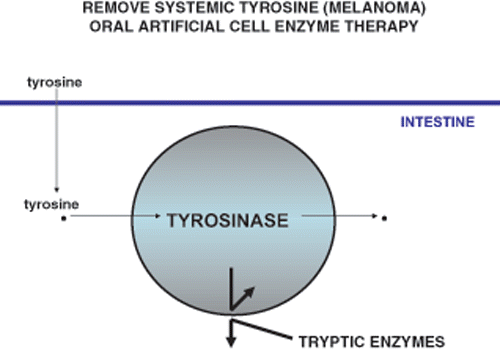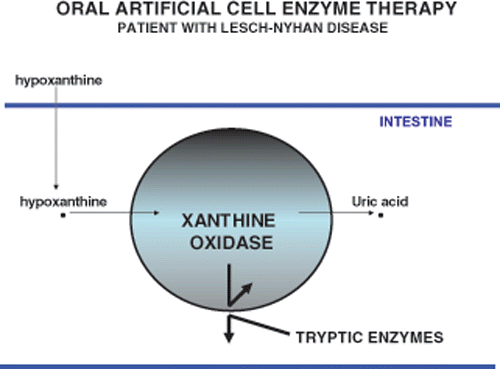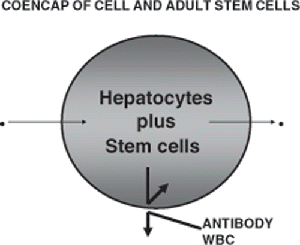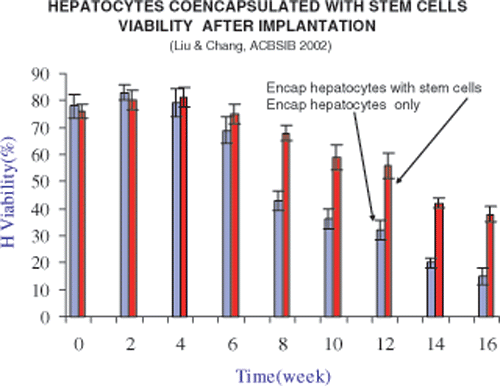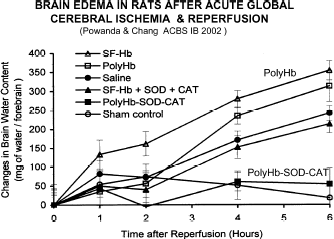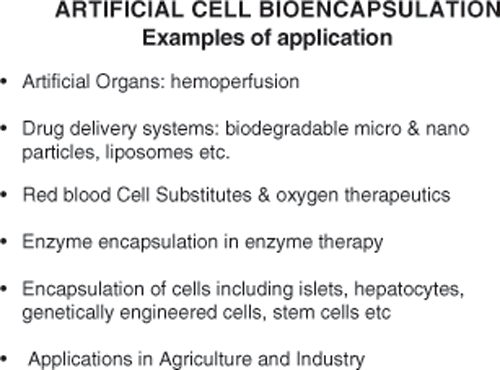Abstract
Artificial cells now ranges from macro-dimensions, to micron-dimensions, to nano-dimensions, and to molecular dimensions. Those in the macro-dimensions are suitable for use in the bioencapsulation of cells, tissues, microorganisms, and bioreactants. Those in the micron-dimensions are suitable for the bioencapsulation of enzymes, microorganisms, peptides, drugs, vaccine, and other materials. Those in the nano-dimension are being used for blood substitutes and carriers for enzymes, peptides, drugs, etc. Those in the molecular-dimensions are used as blood substitutes, crosslinked enzymes etc.
Introduction
Artificial cells in the micro-dimensions were first reported by Chang a number of years ago (Chang, Citation[[1957]], Citation[[1964]], Citation[[1966]], Citation[[1972]]; Chang et al., Citation[[1966]]) (). Biologically active materials inside the artificial cells are prevented from coming into direct contact with external materials like leucocytes, antibodies, or tryptic enzymes. Smaller molecules can equilibrate rapidly across the ultrathin membrane with large surface to volume relationship. A number of potential medical applications using artificial cells have been proposed (Chang, Citation[[1964]], Citation[[1966]], Citation[[1972]]; Chang et al., Citation[[1966]]). However, even at the very beginning, it was necessary to increase this to the macro-dimensions for certain type of bioencapsulation. One example is cell encapsulation (Chang, Citation[[1972]]; Chang et al., Citation[[1966]]) and another example is the encapsulation of adsorbents for use in hemoperfusion (Chang, Citation[[1966]], Citation[[1972]], Citation[[1975]]; Winchester, Citation[[1988]]). Artificial cells (Chang, Citation[[1997a]]) bioencapsulation now range from macro-dimensions, to micron-dimensions, to nano-dimensions, and to molecular-dimensions (). This paper describes some examples from our research using those in the micron-dimensions for the bioencapsulation of enzymes, peptides, drugs, vaccine, and other materials; those in the macro-dimensions for cell encapsulation and encapsulation of bioreactants; those in the molecular-dimensions are used as blood substitutes, crosslinked enzymes etc.; and those in the nano-dimension for blood substitutes, enzymes, peptides, drugs etc.
Artificial Cells in the Micron-Dimensions
Enzyme Therapy by Implantation ()
Figure 3. Basic principle of the use of enzyme artificial cells for implantation in inborn errors of metabolism (e.g., acatelasemia) and cancer (lymphosarcoma).
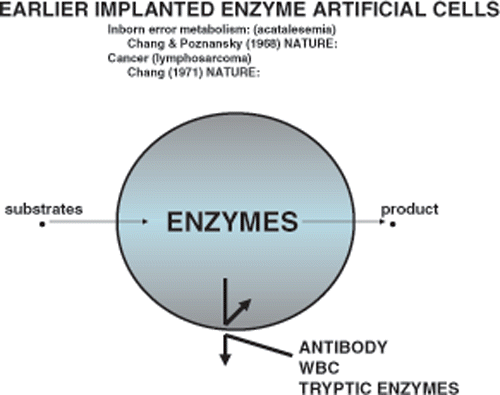
We have earlier implanted artificial cells containing catalase into acatalesemic mice, animals with a congenitical deficiency in catalase (Chang and Poznansky, Citation[[1968]]). This replaces the deficient enzymes and prevented the animals from the damaging effects of oxidants. The artificial cells protect the enclosed enzyme from immunological reactions (Poznansky and Chang, Citation[[1974]]). It was also showed that artificial cells containing asparaginase implanted into mice with lymphosarcoma delayed the onset and growth of lymphosarcoma (Chang, Citation[[1971a]]). The single problem preventing the clinical application of enzyme artificial cells is the need to repeatedly inject these enzyme artificial cells.
Oral Administration to Avoid the Need for Implantation ()
Figure 4. Our recent approach of giving artificial cells orally to avoid the need for implantation. This way, each artificial cell as it travels through the intestine, acts as a microscopic dialyzer. By placing enzyme or other bioreactants inside the artificial cells, they can act as combined dialyzer–bioreactors on their passage through the intestine. After carrying out their function, they are excreted in the stool. Thus there is no accumulation in the body.
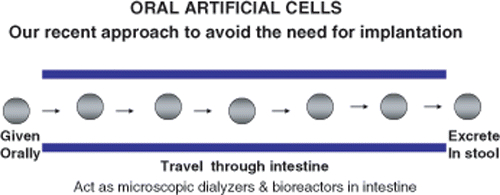
To solve this problem, artificial cells were given orally. As they travel through the intestine, they act as microscopic dialyzers (). By encapsulating enzymes and other material inside the microcapsules, they can act as combined dialyzer–bioreactor (). For example, artificial cells containing urease and ammonia adsorbent were used to lower the systemic urea level (Chang, Citation[[1972]]). We found that microencapsulated phenylalanine ammonia lyase given orally can lower the elevated phenylalanine levels in phenylketonuria (PKU) rats (Bourget and Chang, Citation[[1986]]) (). This is because of our more recent finding of an extensive recycling of amino acids between the body and the intestine (Chang et al., Citation[[1995]]) (). This is now being developed for clinical trial in PKU (Liu et al., Citation[[2002]]; Sarkissian et al., Citation[[1999]]). In addition to PKU other examples our recent studies shows that oral artificial cells containing tyrosinase is effective in lowering systemic tyrosine levels in rats (Yu and Chang, Citation[[2004]]) (). We have also used oral microencapsulated xanthine oxidase to lower the systemic hypoxanthine levels in a patient with Lesch-Nyhan Disease (Palmour et al., Citation[[1989]]) ().
Figure 5. Oral artificial cells containing phenylalanine ammonia lyase for the removal of systemic phenylalanine in the most common inborn error of metabolism, phenylketonuria.
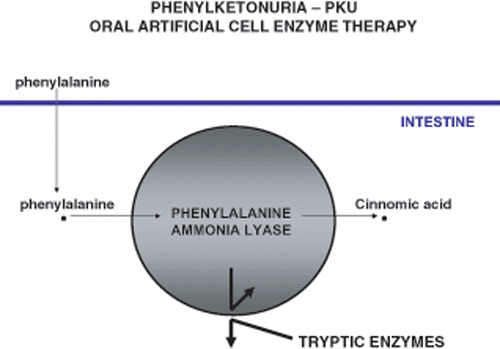
Figure 6. Our new finding that there is an extensive recirculation of amino acids between the body and the intestine. Pancreatic, gastric, intestinal, and other secretions from the body contains a large amount of protein, peptides, and other sources of amino acids. These are digested in the intestine into amino acids that are reabsorbed into the body. Artificial cells containing one enzyme to break down one amino acid can thus break the recirculation for this particular amino acid resulting in decreasing its concentration in the body.
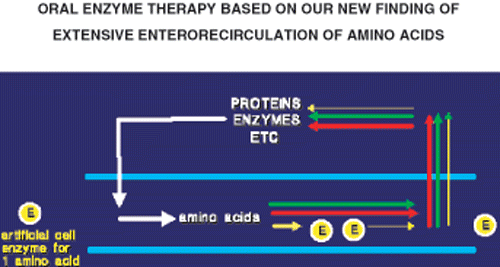
Drug Delivery Systems
Our initial use of polylactide biodegradable semipermeable microcapsules containing enzymes, insulin, hormones, vaccines, and other biologicals in 1976 (Chang, Citation[[1976]]) is now being extended by many groups. This includes our studies on the preparation and characterization of polylactic acid microcapsules containing ciprofloxacin for controlled release (Yu et al., Citation[[1998]]).
Artificial Cells in the Macro-Dimensions
Hemoperfusion
The first successful use of artificial cell in routine clinical use is hemoperfusion (Chang, Citation[[1972]], Citation[[1975]]; Winchester, Citation[[1988]]). After initial clinical trails for poisoning, kidney failure, and liver failure (Chang, Citation[[1975]]), it is now in routine clinical uses (Winchester, Citation[[1988]]).
Cell Encapsulation of Hepatocytes, Islets and Other Endocrine Cells, and Stem Cells
Chang et al. reported the encapsulation of biological cells in 1966 based on a drop method and proposed that “protected from immunological process, encapsulated endocrine cells might survive and maintain an effective supply of hormone” (Chang Citation[[1972]]; Chang et al., Citation[[1966]]) (). Chang approached Conaught Laboratory to develop this for use in islet transplantation for diabetes. Sun from Conaught and his collaborators have later developed this drop-method by using milder physical crosslinking (Lim and Sun, Citation[[1980]]). This resulted in alginate-polylysine-alginate (APA) microcapsules containing cells. They show that after implantation, the islets inside artificial cells remain viable and continued to secrete insulin to control the glucose levels of diabetic rats (Lim and Sun, Citation[[1980]]).
Figure 9. Basic principle of artificial cells for cell encapsulation. The encapsulated cells are retained inside the microcapsules and thus isolated from the external environment. This prevents immunological rejection of the encapsulated cells. However, the membrane can be made permeable to oxygen and nutrients needed by the cell. Also, the products of the cells like insulin, peptide, and other materials can leave the microcapsules.
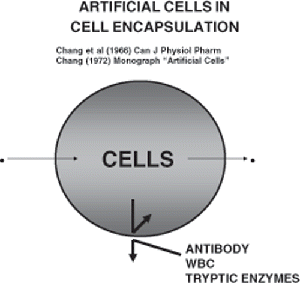
Cell encapsulation for cell therapy has been extensively developed by many groups especially using artificial cells containing endocrine tissues, hepatocytes, and other cells for cell therapy (Chang, Citation[[1995]]; Chang and Prakash, Citation[[2001]]; Dionne et al., Citation[[1996]]; Hunkeler et al., Citation[[1999]]; Kulitreibez et al., Citation[[1999]]; Lim and Sun, Citation[[1980]]; Orive et al., Citation[[2003]]) (). We have been studying the use of implantation of encapsulated hepatocytes for liver support (Brunis and Chang, Citation[[1989]]; Chang, Citation[[2001]]; Wong and Chang, Citation[[1986]], Citation[[1988]], Citation[[1991a]], Citation[[1991b]]; Liu and Chang, Citation[[2000]], Citation[[2002]], Citation[[2003]]). We found that implantation increases the survival of rats in acute liver failure (Wong and Chang, Citation[[1986]]); maintains a low bilirubin level in hyperbilirubinemic Gunn rats (Brunis and Chang, Citation[[1989]]); prevents xenograft rejection (Wong and Chang, Citation[[1988]]). We developed a two step cell encapsulation method to improve the APA method resulting in improved survival of implanted cells (Wong and Chang, Citation[[1991a]], Citation[[1991b]]). Using this two step methods plus the use of co-encapsulation of stem cells and hepatocytes () we have further increased the viability of encapsulated hepatocytes both in culture and also after implantation (Liu and Chang, Citation[[2000]], Citation[[2002]]) (). One implantation of the co-encapsulated hepatocytes-stem cells into Gunn rats lowered the systemic bilirubin levels and maintained this low level for 2 months (Liu and Chang, Citation[[2003]]). Implanted encapsulated hepatocytes can only maintain a low level for 1 month.
Microencapsulated Genetically Engineered Cells
This has been studied out by many groups for potential applications in amyotrophic lateral sclerosis, Dwarfism, pain treatment, IgG1 plasmacytosis, Hemophilia B, Parkinsonism, and axotomized septal cholinergic neurons (Aebischer et al., Citation[[1996]]; Chang and Prakash, Citation[[1998]]) (). One group uses hollow fibers to macroencapsulated genetically engineered cells. This way, the fibers can be inserted and then retrieved after use without being retained in the body (Aebischer et al., Citation[[1996]]).
Figure 12. Basic principle of bioencapsulation of genetically engineered cells is the same as for cell encapsulation.
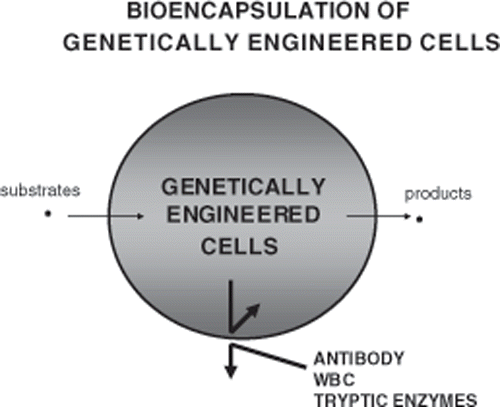
To avoid the need for implantation, we studied the oral use () of microencapsulated genetically engineered nonpathogenic E. coli DH5 cells containing Klebsiella aerogenes urease gene to lower systemic urea in renal failure rats (Chang, Citation[[1997b]]; Prakash and Chang, Citation[[1996]]). However, these genetically engineered microorganism are not sufficiently stable in their ability to remove urea. We are looking at the metabolic induction of lactobacillus similar to those use in yourgart, in order not to introduce genetically engineered cells into the body (Chow et al., Citation[[2003]]).
Artificial Cells in the Molecular Dimensions
Polyhemoglobin as Blood Substitutes
Chang has extended his original approach of artificial cells containing hemoglobin and enzymes (Chang, Citation[[1957]], Citation[[1964]]) to form polyhemoglobin—a molecular version of artificial cells. This is based on his use of bifunctional agents like diacid (Chang, Citation[[1964]], Citation[[1972]]) or later glutaraldehyde (Chang, Citation[[1971b]]) to crosslink hemoglobin molecules into polyhemoglobin (). With problem related to H.I.V. in donor blood, there has been extensive development towards blood substitutes starting in the early 1990's (Chang, Citation[[1997c]], Citation[[1999]], Citation[[2002]], Citation[[2003]]; Winslow, Citation[[2003]]). At present, two of these are in the final stages of clinical trials and waiting for F.D.A. approval. These are developed independently by two groups based on Chang's basic principle of gluataradehyde crosslinked polyhemoglobin (Chang, Citation[[1971b]]). One is pyridoxalated glutaraldehyde human polyhemoglobin (Gould et al., Citation[[1998]], Citation[[2002]]). They show in Phase III clinical trial that this can successfully replace extensive blood loss in trauma surgery by maintaining the hemoglobin level with no reported side effects (Gould et al., Citation[[1998]], Citation[[2002]]). They have infused up to 20 units into individual trauma surgery patients (Gould et al., Citation[[2002]]). Another one is glutaraldehyde crosslinked bovine polyhemoglobin that has been extensive tested in Phase III clinical trials (Pearce and Gawryl, Citation[[1998]]; Sprung et al., Citation[[2002]]). This bovine polyhemoglobin has been approved for veterinary medicine in the U.S. and for routine clinical use in South Africa. The above two polyhemoglobins have been approved for compassionate uses in human and they are waiting for regulatory approval for routine clinical uses in human in North America. They have a number of advantages when compared to donor red blood cells () and they are particularly useful for use in surgery. However, these are only oxygen carriers and do not have all the functions of red blood cells that may be needed for certain clinical conditions (Chang, Citation[[2003]]).
Figure 13. Molecular dimension red blood cell substitutes in the form of polyhemoglobin. This is formed by the intermolecular crosslinking of hemoglobin into a soluble complex. In this form, they are retained in the circulation.
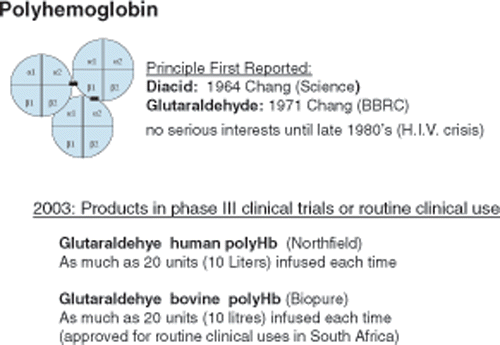
Figure 14. Comparison of polyhemoglobin with donor red blood cells. Polyhemoglobin has many advantages over red blood cells and is useful for use during surgery. However, it cannot be used in a number of other clinical conditions. This is because unlike red blood cells (RBC), polyhemoglobin is only an oxygen carrier. It does not have RBC enzymes needed for many functions including the removal of oxygen radicals. Furthermore, its circulation time is much shorter than that of RBC.
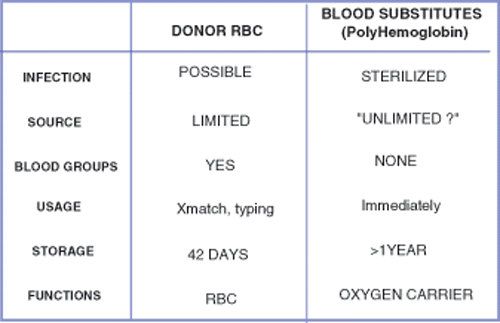
Polyhemoglobin Crosslinked with RBC Antioxidant Enzymes
Reperfusion using oxygen carrier alone in sustained severe hemorrhagic shock or sustained ischemic organs as in stroke, myocardial infarction, or organ transplantation may result in the production of oxygen radicals and tissue injury (Chang, Citation[[1997c]], Citation[[2002]]; Gould et al., Citation[[2002]]). We are using a crosslinked polyhemoglobin-superoxide dismutase-catalase (PolyHb-SOD-CAT) (D’Agnillo and Chang, Citation[[1998a]], Citation[[1998b]], Powanda and Chang, Citation[[2002]], Razack et al., Citation[[1997]]) (). Unlike PolyHb, PolyHb-SOD-CAT did not cause a significant increase in oxygen radicals when it is used to reperfuse ischemic rat intestine (Razack et al., Citation[[1997]]). More recently (Powanda and Chang, Citation[[2002]]), in a transient global cerebral ischemia rat model, we found that after 60 min of ischemia, reperfusion with polyHb resulted in significant increases in blood–brain barrier and the breakdown of blood–brain barrier (). On the other hand, polyHb-SOD-CAT did no result in these adverse changes (Powanda and Chang, Citation[[2002]]) ().
Figure 15. Crosslinking of hemoglobin with two RBC enzymes to form polyhemoglobin-catalase-superoxide dismutase (PolyHb-CAT-SOD). Unlike polyhemoglobin, this has RBC enzymes that can remove oxygen radicals.
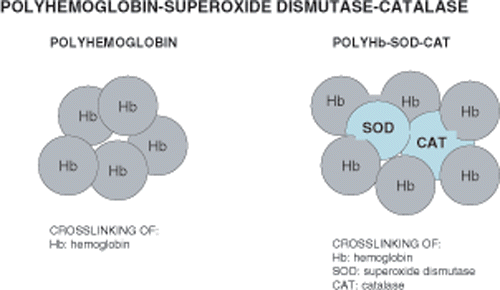
Figure 16. In conditions like severe sustained hemorrhagic shock, stroke, myocardial infarction and organ transplantation, reperfusion with polyhemoglobin can sometimes result in oxygen radicals that causes tissue injury. PolyHb-CAT-SOD can supply oxygen and at the same time significantly lower any oxygen radicals formed.
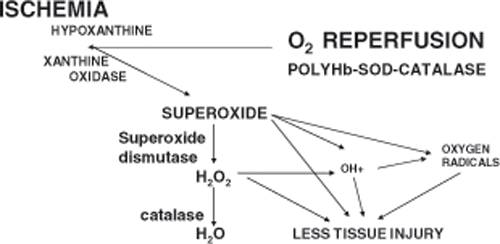
Polyhemoglobin Crosslinked with Tyrosinase
Crosslinking tyrosinase with hemoglobin results in a soluble polyhemoglobin-tyrosinase complex. This has the dual function of lowering systemic tyrosine that has the potential to slow the growth of melanoma (Yu and Chang, Citation[[2004]]). At the same time, polyhemoglobin, being in solution, can more readily perfuse the under perfuse melanoma blood vessels bring more oxygen for more effective radiation therapy (Yu and Chang, Citation[[2004]]).
Artificial Cells in the Nano-Dimensions
Blood Substitutes
Chang's original idea of a complete artificial red blood cell (Chang, Citation[[1957]], Citation[[1964]]) is now being developed as third generation blood substitute (Chang, Citation[[2003]]). Hemoglobin lipid vesicles is one of these approaches (Philips et al., Citation[[1999]]; Rudolph et al., Citation[[1997]]; Tsuchida, Citation[[1998]]). We are using a different approach based on biodegradable polymer and nanotechnology resulting in nano artificial RBC of 80 to 150 nanometre diameter (Chang and Yu, Citation[[1998]]; Chang et al., Citation[[2003]]; Yu and Chang, Citation[[1994]]). These nano artificial rbc contain all the red blood cell enzymes needed for the long term function of the nano artificial RBC (Chang et al., Citation[[2003]]) (). Our recent studies show that using a polyethylene-glycol-polylactide copolymer membrane we are able to increase the circulation time of these nano artificial rbc to double that of polyHb (Chang et al., Citation[[2003]]) ().
Figure 18. Nanodimension artificial red blood cells with polyethylene-glyco-polylactide membrane. In addition to hemoglobin, this contains the same enzymes that are normally present in red blood cells. Thus, it has the complete function of the red blood cells.

Figure 19. Nanodimension artificial red blood cells with polyethylene-glyco-polylactide membrane. The circulation time is double that of polyhemoglobin. The circulation half time of polyhemoglobin in human is about 24 hours. This means that the nanodimension artificial RBC may have a circulation time of about 48 h in human.

Drug Delivery
We have been studying the preparation and characterization of polylactic acid nanocapsules containing ciprofloxacin for controlled release (Yu et al., Citation[[1999]]). The nanocapsules described above (Chang and Yu, Citation[[1998]]; Chang et al., Citation[[2003]]; Yu and Chang, Citation[[1994]]) are also useful for the delivery of biologically active proteins and peptides. Other approaches based on nanodimension artificial cells in the form of liposomes, nanoparticles, and nanocapsules are being increasing used by many groups for drug delivery.
General
This paper only briefly summarizes some of the research from this group on artificial cells in the macro, micro, nano, and molecular dimensions. Bioencapsulation of biosorbent is rather simple and therefore has been in routine clinical uses after only a few years of research and development (Chang, Citation[[1975]]; Winchester, Citation[[1988]]). Some areas of microencapsulation of drugs for delivery are also straight forward and are in clinical applications. However, in the more complicated areas like cell encapsulation and blood substitutes one cannot expect that clinical application will come after just a few years of research and development. There are many areas of applications being explored by many groups around the world (). The promise and potential of artificial cells also comes with the need for further development towards actual applications. Much needs to be done in order to move the more advance uses of artificial cells to fruitful applications ().
Figure 21. With the promise and progress in artificial cells, also come with the need for further development towards actual applications. Much needs to be done in order to move the more advanced application of artificial cells to fruitful applications.
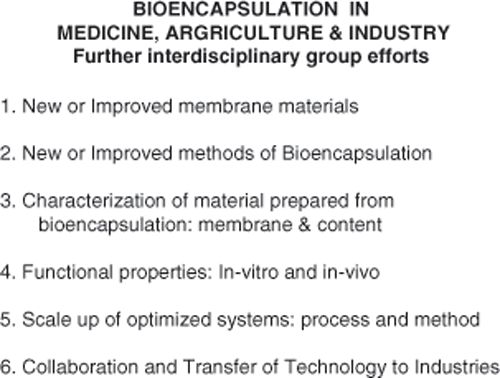
Artificial cell is a rapidly evolving area and rapidly updating and links to other groups around the world can be found on our McGill University website: www.artcell.mcgill.ca.
Acknowledgments
This author acknowledges the supports of the Canadian Institutes of Health Research, the “Virage” Centre of Excellence in Biotechnology from the Quebec Ministry, the MSSS-FRSQ Research Group award on Blood Substitutes in Transfusion Medicine from the Quebec Ministry of Health and the Research Fund of the Bayer/Canadian Blood Agency/Hema Quebec/Canadian Institutes of Health.
References
- Aebischer P., Schluep M., Deglon N., Joseph J. M, Hirt L., Heyd B., Goddard M., Hammang J. P., Zurn A. D., Kato A. C., Regli F., Baetge E. E. Intrathecal delivery of CNTF using encapsulated genetically modified xenogeneic cells in amyotrophic lateral sclerosis patients. Nat. Med. 1996; 2: 696–699, [PUBMED], [INFOTRIEVE], [CSA]
- Bourget L., Chang T. M. S. Phenylalanine ammonia-lyase immobilized in microcapsules for the depleture of phenylalanine in plasma in phenylketonuric rat model. Biochim. Biophys. Acta 1986; 883: 432–438, [PUBMED], [INFOTRIEVE]
- Bruni S., Chang T. M. S. Hepatocytes immobilized by microencapsulation in artificial cells: Effects on hyperbiliru-binemia in Gunn Rats. J. Biomat. Artif. Cells and Artif. Org. 1989; 17: 403–412
- Chang T. M. S. ‘Hemoglobin Corpuscles’, Report of a research project for Honours Physiology, Medical Library, McGill University. Also reprinted as part of ‘30 anniversary in artificial red blood cells research’. J. Biomaterials, Artificial Cells & Artificial Organs 1957; 16: 1–9, 1988[INFOTRIEVE]
- Chang T. M. S. Semipermeable microcapsules. Science 1964; 146: 524–525, [PUBMED], [INFOTRIEVE]
- Chang T. M. S. Semipermeable aqueous microcapsules [“artificial cells”]: with emphasis on experiments in an extracorporeal shunt system. Trans. Am. Soc. Artif. Intern. Organs 1966; 12: 13–19, [PUBMED], [INFOTRIEVE]
- Chang T. M. S. The in vivo effects of semipermeable microcapsules containing L-asparaginase on 6C3HED lymphosarcoma. Nature 1971a; 229(528)117–118, [PUBMED], [INFOTRIEVE]
- Chang T. M. S. Stabilization of enzyme by microencapsulation with a concentrated protein solution or by crosslinking with glutaraldehyde. Biochem. Biophys. Res. Com. 1971b; 44: 1531–1533, [PUBMED], [INFOTRIEVE]
- Chang T. M. S. Artificial Cells. Thomas Publisher, Springfield, C.C. 1972; pp. 1–207, (Available for free online viewing at www.artcell.mcgill.ca)
- Chang T. M. S. Microencapsulated adsorbent hemoperfusion for uremia, intoxication and hepatic failure. Kidney Int. 1975; 7: S387–S392
- Chang T. M. S. Biodegradable semipermeable microcapsules containing enzymes, hormones, vaccines, and other biologicals. J. Bioengineering 1976; 1: 25–32
- Chang T. M. S. Artificial cells with emphasis on bioencapsulation in biotechnology. Biotechnology Annual Review 1995; 1: 267–295, [PUBMED], [INFOTRIEVE]
- Chang T. M. S. Artificial cells. Encyclopedia of Human Biology. 2nd Ed., Renals Dulbecco. Academic Press Inc., San Diego, CA 1997a; pp. 457–463
- Chang T. M. S. Live E. coli cells to treatment uremia: replies to letters to the editor. Nature Medicine 1997b; 3: 2–3, [CROSSREF], [CSA]
- Chang T. M. S. Blood Substitutes: Principles, Methods, Products and Clinical Trials. Karger, Basel 1997c; Vol. 1: pp. 1–138, (available for free online viewing at www. artcell.mcgill.ca)
- Chang T. M. S. Artificial blood: a prospective. Trends in Biotechnology 1999; 17: 61–67, [PUBMED], [INFOTRIEVE], [CROSSREF], [CSA]
- Chang T. M. S. Bioencapsulated hepatocytes for experimental liver support. Journal of Hepatology 2001; 34: 148–149, [PUBMED], [INFOTRIEVE], [CROSSREF]
- Chang T. M. S. Oxygen carriers. Current Opinion in Investigational Drugs 2002; 3(8)1187–1190, [PUBMED], [INFOTRIEVE], [CSA]
- Chang T. M. S. New generations of red blood cell substitutes. J. Internal Medicine. 2003; 253: 527–535, [CROSSREF]
- Chang T. M. S., Poznansky M. J. Semipermeable microcapsules containing catalase for enzyme replacement in acatalsaemic mice. Nature 1968; 218(5138)242–245
- Chang T. M. S., Prakash S. Therapeutic uses of microencapsulated genetically engineered cells. Molecular Medicine Today 1998; 4: 221–227, [PUBMED], [INFOTRIEVE], [CROSSREF], [CSA]
- Chang T. M. S., Prakash S. Procedure for microencapsulation of enzymes, cells and genetically engineered microorganisms. Molecular Biotechnology 2001; 17: 249–260, [PUBMED], [INFOTRIEVE], [CROSSREF]
- Chang T. M. S., Yu W. P. Nanoencapsulation of hemoglobin and red blood cell enzymes based on nanotechnology and biodegradable polymer. Blood Substitutes: Principles, Methods, Products and Clinical Trials, T. M. S. Chang. Karger, Basel 1998; Vol. 2: pp. 216–231
- Chang T. M. S., Bourget L., Lister C. New theory of enterorecirculation of amino acids and its use for depleting unwanted amino acids using oral enzyme-artificial cells, as in removing phenylalanine in phenylketonuria. Artificial Cells, Blood Substitutes & Immobilization Biotechnology 1995; 25: 1–23
- Chang T. M. S., MacIntosh F. C., Mason S. G. Semipermeable aqueous microcapsules: I. Preparation and properties. Can. J. Physiol. Pharmacol. 1966; 44: 115–128, [PUBMED], [INFOTRIEVE]
- Chang T. M. S., Powanda D., Yu W. P. Analysis of polyethylene-glycol-polylactide nano-dimension artificial red blood cells in maintaining systemic hemoglobin levels and prevention of methemoglobin formation. Artif. Cells, Blood Substitutes & Biotechnology, An International Journal 2003; 31(3)231–248, [CROSSREF]
- Chow K. M., Liu Z. C., Prakash S., Chang T. M. S. Free and icroencapsulated Lactobacillus and effects of metabolic induction on Urea Removal Artificial Cells. Blood Substitutes & Biotechnology 2003; 33: 425–434, in press, [CROSSREF]
- D’Agnillo F., Chang T. M. S. Polyhemoglobin-superoxide dismutase, catalase as a blood substitute with antioxidant properties. Nature Biotechnology 1998a; 16(7)667–671, [CROSSREF], [CSA]
- D'Agnillo F., Chang T. M. S. Absence of hemoprotein-associated free radical events following oxidant challenge of crosslinked hemoglobin-superoxide dismutase-catalase. Free Radical Biology & Medicine 1998b; 24(6)906–912, [CROSSREF], [CSA]
- Dionne K. E., Cain B. M., Li R. H., Bell W. J., Doherty E. J., Rein D. H., Lysaght M. J., Gentile F. T. Transport characterization of membranes for immunoisolation. Biomaterials 1996; 17: 257–266, [PUBMED], [INFOTRIEVE], [CROSSREF], [CSA]
- Gould S. A., Sehgal L. R., Sehgal H. L., DeWoskin R., Moss G. S. The clinical development of human polymerized hemoglobin. Blood Substitutes: Principles, Methods, Products and Clinical Trials, T. M. S. Chang. Karger, Basel 1998; Vol. 2: pp. 12–28
- Gould S. A., Moore E. E., Hoyt D. B., Ness P. M., Norris E. J., Carson J. L., Hides GA., Freeman I. H. G., DeWoskin R., Moss G. S. The life-sustaining capacity of human polymerized hemoglobin when red cells might be unavailable. Journal of the American College of Surgeons 2002; 195: 445–452, [PUBMED], [INFOTRIEVE], [CROSSREF], [CSA]
- Bioartificial Organs A: Technology, Medicine and Material, D. Hunkeler, A., A. D. Prokop, R. Rajotte, M. Sefton. Ann N.Y. Acad. Sci. 1999; Vol. 875: pp. 271–279, (1999). Acad. Sci., 831
- Cell Encapsulation Technology and Therapy, W. M. Kulitreibez, P. P. Lauza, W. L. Cuicks. Burkhauser, Boston 1999; pp. 1–450
- Lim F., Sun A. M. Microencapsulated islets as bioartificial endocrine pancreas. Science 1980; 210: 908–909, [PUBMED], [INFOTRIEVE]
- Liu Z., Chang T. M. S. Effects of bone marrow cells on hepatocytes: when co-cultured or co-encapsulated together. Artif Cells, Blood Substitutes & Immob. Biotechnology, An International Journal 2000; 28(4)365–374
- Liu Z. C., Chang T. M. S. Transplantation of co-encapsulated hepatocytes and marrow stem and cells into rats. Artificial Cells, Blood Substitutes & Immob. Biotechnology, An International Journal 2002; 30: 99–112, [CROSSREF]
- Liu Z. C., Chang T. M. S. Coencapsulation of stem cells and hepatocytes: in-vitro conversion of ammonia and in-vivo studies on the lowering of bilirubin in gunn rats after transplantation. Interantional Journal of Artificial Organs 2003; 26(6)491–497
- Liu J., Jia X., Zhang J., Xiang G., Hu W., Zhou Y. Study on a novel strategy to treatment of phenylketonuria. Artificial Cells, Blood Substitutes & Immobilization Biotechnology 2002; 30: 243–258, [CROSSREF]
- Orive G., Hernandez R. M., Gascon A. R., Calafiore R., Chang T. M. S. Cell encapsulation: promise and progress. Nature Medicine 2003; 9: 104–107, [PUBMED], [INFOTRIEVE], [CROSSREF], [CSA]
- Palmour R. M., Goodyer P., Reade T., Chang T. M. S. Microencapsulated xanthine oxidase as experimental therapy in Lesch-Nyhan Disease. Lancet 1989; 2(8664)687–688, [PUBMED], [INFOTRIEVE], [CROSSREF], [CSA]
- Pearce L. B., Gawryl M. S. Overview of preclinical and clinical efficacy of biopure's HBOCs. Blood Substitutes: Principles, Methods, Products and Clinical Trials, T. M. S. Chang. Karger, Basel 1998; Vol. 2: pp. 82–98
- Philips W. T., Klpper R. W., Awasthi V. D., Rudolph A. S., Cliff R., Kwasiborski V. V., Goins B. A. Polyethylene glyco-modified liposome-encapsulated hemoglobin: a long circulating red cell substitute. J. Pharm. Exp. Therapeutics 1999; 288: 665–670, [CSA]
- Powanda D., Chang T. M. S. Cross-linked polyhemoglobin-superoxide dismutase-catalase supplies oxygen without causing blood brain barrier disruption or brain edema in a rat model of transient global brain ischemia-reperfusion. Artificiall Cells, Blood Substitutes & Immob. Biotechnology, An International Journal 2002; 30: 25–42, [CSA]
- Poznansky M. J., Chang T. M. S. Comparison of the enzyme kinetics and immunological properties of catalase immobilized by microencapsulation and catalase in free solution for enzyme replacement. Biochim. Biophys. Acta 1974; 334: 103–115
- Prakash S., Chang T. M. S. Microencapsulated genetically Engineered live E. coli DH5 cells administered orally to maintain normal plasma urea level in uremic rats. Nature Medicine 1996; 2(8)883–887, [PUBMED], [INFOTRIEVE], [CROSSREF], [CSA]
- Razack S., D'Agnillo F., Chang T. M. S. Effects of Polyhemoglobin-catalase-superoxide dismutase on oxygen radicals in an ischemia-reperfusion rat intestinal model. Artificial Cells, Blood Substitutes and Immobilization Biotechnology. 1997; 25: 181–192, [CSA]
- Red Blood Cell Substitutes, A. S. Rudolph, R. Rabinovici, G. Z. Feuerstein. Marcel Dekker Inc, N.Y. 1997; pp. 1–485
- Sarkissian C. N., Shao Z., Blain F., Peevers R., Su H., Heft R., Chang T. M. S., Scriver C. R. A different approach to treatment of phenylketonuria: phenylalanine degradation with recombinant phenylalanine ammonia lyase. Proc. Natl. Acad. Sci. 1999; 96: 2339–2344, [PUBMED], [INFOTRIEVE], [CROSSREF], [CSA]
- Sprung J., Kindscher J. D., Wahr J. A., Levy J. H., Monk T. G., Moritz M. W., O'Hara P. J. The use of bovine hemoglobin glutamer-250 (Hemopure) in surgical patients: results of a multicenter, randomized, single-blinded trial. Anesth. Analg. 2002; 94: 799–808, [PUBMED], [INFOTRIEVE], [CROSSREF]
- Blood Substitutes: Present and Future Perspectives, E. Tsuchida. Elsevier, Amsterdam 1998; pp. 1–267
- Winchester J. F. Replacement of renal function by dialysis. Hemoperfusion, J. F. Maher. Kluwer Academic Publisher, Boston 1988; pp. 439–592
- Winslow R. Current status of blood substitute research: towards a new paradigm. J. Int. Med. 2003; 253: 508–517, [CROSSREF]
- Wong H., Chang T. M. S. Bioartificial liver: implanted artificial cells microencapsulated living hepatocytes increases survival of liver failure rats. Int. J. Artif Organs 1986; 9: 335–336, [PUBMED], [INFOTRIEVE]
- Wong H., Chang T. M. S. The viability and regeneration of artificial cell microencapsulated rat hepatocyte xenograft transplants in mice. J. Biomaterials, Artificial Cells and Artificial Organs 1988; 16: 731–740
- Wong H., Chang T. M. S. Microencapsulation of cells within alginate poly-L-lysine microcapsules prepared with standard single step drop technique: histologically identified membrane imperfections and the associated graft rejection. Biomaterials, Artificial Cells and Immobilization Biotechnology 1991a; 19: 675–686, [CSA]
- Wong H., Chang T. M. S. A novel two-step procedure for immobilizing living cells in microcapsule for improving xenograft survival. Biomaterials, Artificial Cells and Immobilization Biotechnology 1991b; 19: 687–698, [CSA]
- Yu W. P., Chang T. M. S. Submicron biodegradable polymer membrane hemoglobin nanocapsules as potential blood substitutes: A preliminary report. J. of Artificial Cells, Blood Substitutes and Immobilization Biotechnology (Guest editor: R. Winslow) 1994; 22: 889–894
- Yu B. L., Chang T. M. S. Effects of combined oral administration and intravenous injection on maintaining decreased systemic tyrosine levels in rats. Artificial Cells, Blood Substitutes & Biotechnology, An International Journal 2004; 34: 129–147, in this issue[CROSSREF]
- Yu W. P., Wong J., Chang T. M. S. Preparation and characterization of polylactic acid microcapsules containing ciprofloxacin for controlled release. J. Microencapsulation 1998; 15: 515–523, [PUBMED], [INFOTRIEVE], [CSA]
- Yu W. P., Wong J. P., Chang T. M. S. Biodegradable polylactic acid nanocapsules containning ciprofloxacin: preparation and characterization. Artif Cells, Blood Substitutes & Immob. Biotechnology, An International Journal 1999; 27(3)263–278, [CSA]
